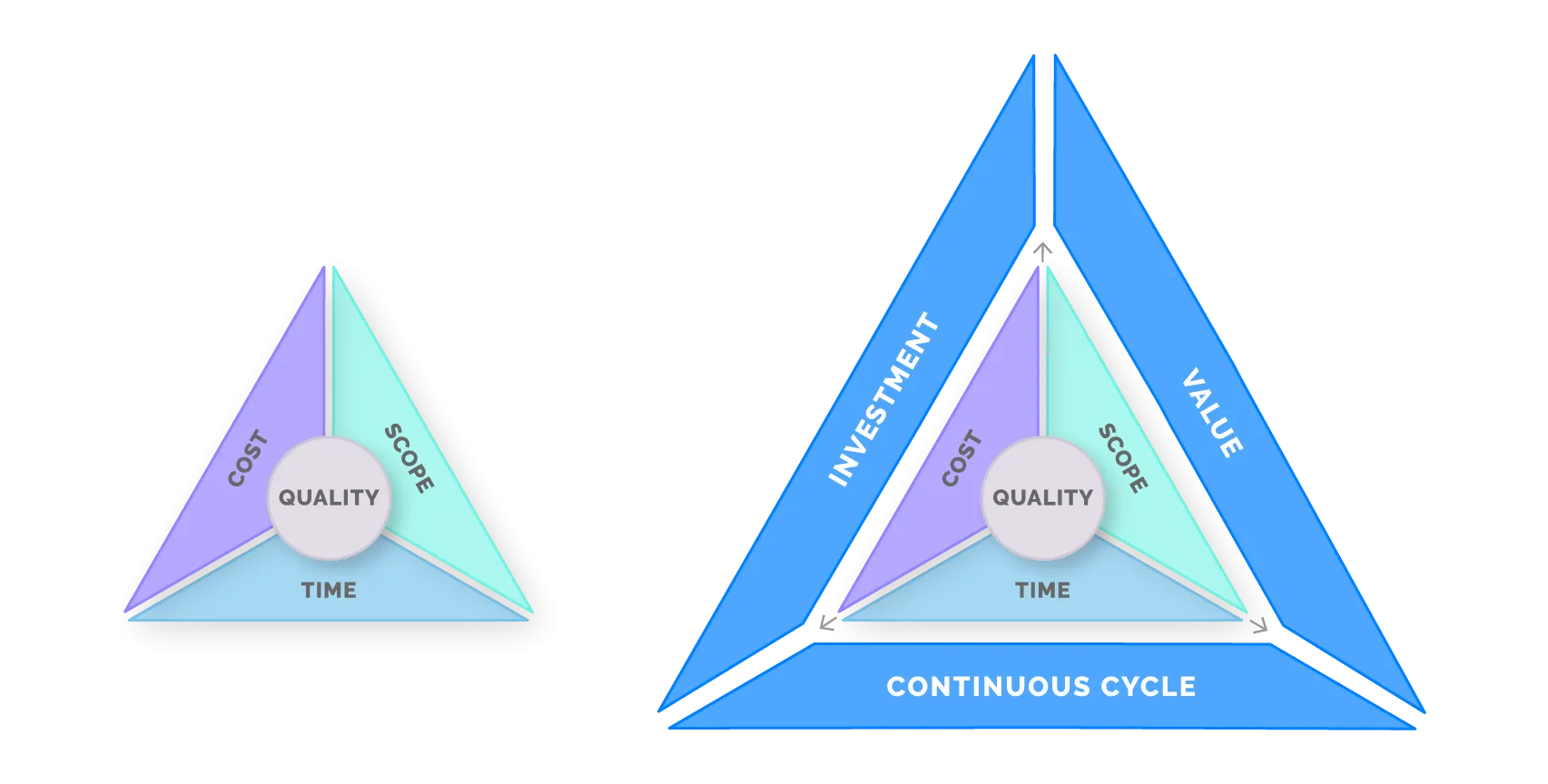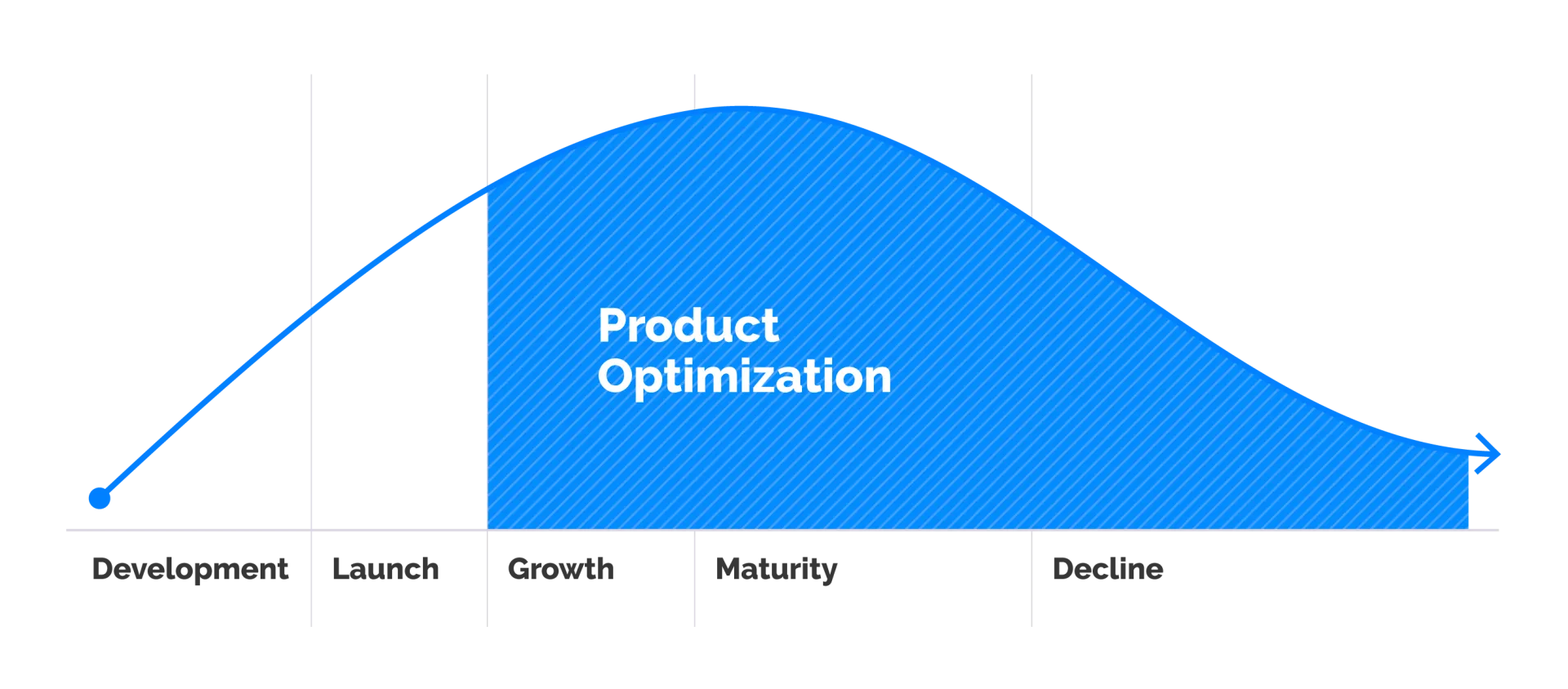
One of the most important things we do for our clients is to help shift the organization’s mindset from focusing on the project (the process) to thinking in terms of creating a digital product (the asset). Projects get you from one point to another, but products solve people's problems.
This distinction is especially important in the digital space where continuous improvement is not just easier than with a physical product, but the proven and preferred way to operate for today’s leading digital organizations.
The traditional project mindset, as depicted in the classic project management triangle focuses on delivering a specific scope within a defined timeframe and budget.

The product mindset expands these constraints to address long term impact: creating value for the customer; continuously improving the product over time; and making a long term investment. A digital product will start with a project, but it has a lifecycle: the investment approach, marketing strategy, and data and analytics drive business results that live on after the initial project is complete.
Creating a digital product still requires project management rigor and discipline and none of this is to say that project management isn't a vital component of success. However, this change in mindset requires a fundamental change in the way digital teams approach their work, from a focus on short-term goals to a long-term vision for the product.
Leading digital organizations make five key shifts to achieve this mindset:
Project thinking is inherently inside out - what is everything that we think we have to do to get this done? Product thinking reverses that to - what do we have to ultimately create to be successful?
It's natural for organizations to prioritize their own needs and wants when planning a project, but the truth is, this approach can lead to a product that doesn't meet the needs of its intended audience.
Too often we see the majority of the requirements coming from within the organizations we are working with. Key stakeholders lobby to have the features and content they want to deliver to their audience. This stems from an inherent fear that if they don't advocate for having their own needs met upfront, they won’t make it into scope.
Leading digital organizations operate differently by taking the time to study their audience’s needs through UX research and thinking in terms of the strategic environment in which a product will operate.
This helps them to identify their audience’s pain points and preferences, as well as address competitive alternatives to ensure that the result is a product that is tailored to meet their customers needs. By putting that audience first, they are creating products that truly resonate and drive success for their organizations.
Projects have a start and an end, but products have a lifecycle of continuous, iterative innovation.
Moving away from a fixation on the one big “launch” is a mentality that is inherently hard for most project stakeholders who view the success of the effort in terms of when it will all be done.
A product lifecycle approach takes into account the entire lifespan of a product, from development to retirement. This means that instead of just focusing on completing a project, you are constantly assessing and improving the product to ensure it remains relevant and successful in the market.

Phase2’s EVP of Delivery, Ellie Power, compared this shift in thinking to a marriage versus a wedding in her blog post, Rethinking Your Digital Product Strategy.
"If the launch day is the wedding, the life of the digital product is the marriage - it’s a long-term partnership full of evolution and insights and unexpected breakthroughs, designed to provide value in the form of business results."
A product lifecycle approach also encourages innovation and creativity. By constantly assessing the product and looking for ways to improve it, you are able to stay ahead of the competition and keep up with changing market trends. This can lead to exciting new developments and opportunities for growth and improvements to the product over time.
Projects measure scope - how much of the planned functionality was completed on time. Products measure value - how your product is impacting users and the business as a whole.
To be product-centric you need to look beyond the completion of tasks and focus in terms of whether customer expectations and needs are met (external) and whether business results are being realized (internal).
Measuring product value requires a different approach than measuring project scope. It requires preparing your systems to collect the relevant data necessary to understand impact, which can often be overlooked in most project costs and plans. It is essential that these be considered upfront to shift to having a product whose value can be measured and proven.
We look at things like user feedback (qualitative), engagement metrics (quantitative), and business results (e.g. revenue, conversion). To quantify results we build digital measurement plans.
A product can have all the features and content in the world, but if it's not meeting the needs of its users or helping the business achieve its goals, then we are still thinking in project scope terms.
Lori Barshinger, VP, Solution Design and Delivery, addresses this misalignment in her blog post Ruthless Prioritization for Website Optimization.
“Let’s be honest, your users don’t come to read the entire encyclopedia of your business. They won't be rummaging through the 8-level-deep navigation to figure out whether to engage with your company. They came here for a specific reason, a task: to learn, to do, or to buy.”
Projects avoid risk. Products embrace calculated risks.
The most forward leaning digital organizations we work with are not afraid to run trial and error experiments designed to optimize the product over time. They make the shift from having a “build it all at once” mindset to embracing a culture of experimentation.
Experimenting with your digital products allows you to be more agile and adaptable by testing the waters to see what works and what doesn't. As a result, you can make adjustments and improvements along the way instead of building everything at once and then realizing that it doesn't work as well as you thought it would.
Embracing experimentation can also lead to innovation. When you're constantly trying new things and taking risks, you might stumble upon something that's completely new and exciting. This can set you apart from your competitors and give you an edge in the market.
Director, Marketing Services Annie Stone explains how leading digital organizations embrace experimentation in her blog post, Creating a Culture of Experimentation Within Your Organization.
“...in a world where customer experience is everything, a solid experimentation culture can and does make the difference between capturing audience loyalty, or losing it to a competitor. Successful and rapid innovations in customer experience are based on data-driven hypotheses and testing…”
Projects have a cost, a budget that has been allowed. Products have an investment, a calculated expenditure to drive value.
Of course, project cost control is a necessity, but it's critical for product owners to frame that cost as an investment over a long period of time.
Justifying a project cost involves demonstrating that the expected benefits of the project outweigh the costs which is often measured in terms of return on investment (ROI) for most projects.
In contrast to project costs, product investments also consider strategic factors such as market demand, competition, and product alternatives that ensure that the investment is aligned with the company's overall strategy and goals.
For this reason, products are best measured in terms of total cost of ownership (TCO) over its useful lifetime - meaning their costs are measured not just in terms of the original investment but calculating all of its costs over the lifecycle compared against its lifetime benefits and impacts to the organization like increased revenue, market share, or customer satisfaction and retention - the result should be a net product benefit.
The leading digital organizations that are making these shifts are creating products that deliver long-term value to both the customer and their businesses in ways that transcend a finite project mindset.
We hope you enjoyed reading the Phase2 blog! Please subscribe for regular updates and industry insights.
Jeff Walpole
The original version of this page was published at: https://www.phase2technology.com/blog/leading-digital-organizations-adopt-a-product-mindset
From engineering interconnected patient experiences to designing new digital platforms, our experience with hospitals and healthcare systems is extensive and touches on every facet of the business.
OR, SAYING "YES, AND" TO THE CORONAVIRUSNB: This is a long post, so think of it as a resource to revisit rather than something to ingest in one sitting. I mean, who has the ...read more
Join Phase2 Strategists Annie Stone and Karina Schuelke as they discuss implementing multi-touch attribution to help your marketing efforts thrive.Unlock insights in your data, create ...read more
Diversity, equity, and inclusion (DEI) work is a journey. We’re all at various points along the continuum and the work is never finished. In addition, DEI is heavily nuanced ...read more
At Phase2 we are united in our approach to accessibility—working together as both advocates and practitioners because we believe that creating accessible user experiences is ...read more